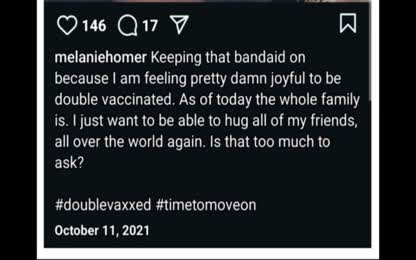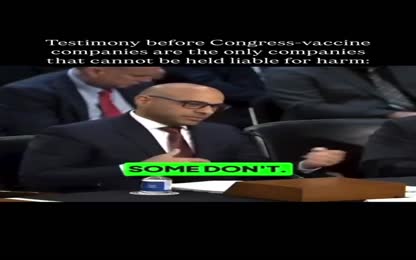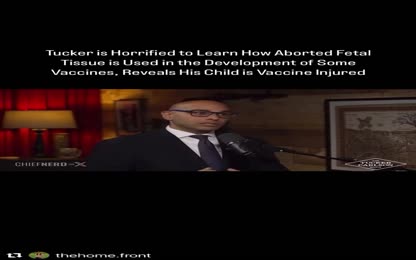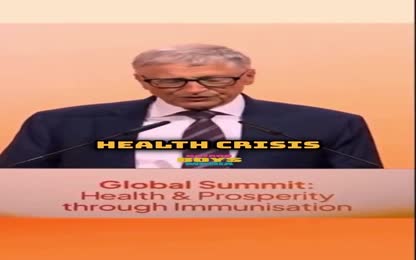Advertisement
Dr Robert Malone - Inventor mRNA Vaccines
15 Minute video with Dr Robert Malone - The inventor of the mRNA Vaccines
Summary : They didn’t expect the Spike Protein from the vaccine to move from the muscle in the arm from where it was injected and travel to other parts of the body causing harm.
They believe the Spike Protein could even reach the bone marrow and lead to people developing leukaemia (Blood Cancer) - only time will tell.
- Category: Uncategorized
- Duration: 15:01
- Date: 2021-06-13 16:01:21
- Tags: no-tag
1 Comments
Video Transcript:
So then there are two other harms that are potentially involved in this vaccine. I wanted to get your input on whether it's worth worrying about these things. One of them, as made famous by Garrett Van Den Bush, who was a guest on this program, is the hazard of the vaccines because they create a very concentrated evolutionary push on spike protein alone that vaccinating into a pandemic rather than in advance of the pandemic is liable to cause the evolution of escape mutants and that it could in fact make a much worse pandemic in the end. So this isn't a theoretical, this is a real, it's real. We already have the data. Oh, there we go. There you go. Okay, so Byron Brittle did a freedom of action request of the Japanese government for the Pfizer data, and he got a bio distribution chart. And I'm pretty sure I linked to the original data in my paper. And this graph was created from that Pfizer data. So this is not the Pfizer data itself in the Pfizer study. This is a graph and people have double checked and triple checked this. It's a summary graphic. So that you've seen, I did review the primary data. And I concur that the primary data is consistent with the graph that you have nicely summarized. Right. And so what you see from this graph is that when you inject in the shoulder, it, um, these, do you want to walk through the, to teach the listener how it shows that? How it shows? Yeah, what you're just saying. So yeah, there are some of these people, some people will just listen to this. So what we're looking at is a graph of different lines of concentration of spike protein in various tissues. Yes, it's a lipid nanoparticle. Oh, it's the lipid nanoparticle, which is the delivery mechanism. Right. It's like the fed, it is the drug. Well, for people at home, it's, it's the box. It's the box in which the mRNA for the drug. So the mRNA is what causes the manufacturer of the spike protein. But if you find the lipid nanoparticles, that tells you that your drug got to this location. Right. It's the delivery box. Effectively, it's the FedEx delivery box that has the mRNA inside. This, this is your exactly right. This is the lipid component. Yeah. That does the delivery. Okay. So good. So what we've got here are different lines that tell you over time from a quarter of an hour to 48 hours, where you find what the concentration in various tissues are. And you've got some strong signals here. You've got it in a whole blood, not surprisingly, over the first four hours. In other words, it's moving around. It's circulating. That in and of itself is unusual. And it should be, it wasn't so, so the, forgive me. Just to get a little more precise, we've administered by needle into the deltoid of this complex. Yeah. And you're just tracking the lipid part of it now. There's also an RNA part of it. But as you say, it quickly moves into the blood. Plasma is the cell-free fraction. That's the yellow mustard line. And the gray line is whole blood. So that includes the cellular part of blood. Yeah. Okay. Carry on. Okay. And then we get lines that rise. So all of these things decline as basically this diffuses through the body, which actually is not what you would hope. You would hope it would stay in the arm. But it's basically diffusing through the body. So concentrations are dropping as it gets more and more evenly distributed. And then concentrations are rising conspicuously in two places as we close in on 48 hours. One of them is in the ovaries where it goes sky high. That's really frightened. Anybody that's looked at this data says, what? Yeah. That is a very frightening thing. And it's the cognitive dissonance between what the CDC says is that this is safe for pregnant women. Right. This is perfectly safe. And it's on the CDC website. It's unbelievable. It's some level. It's not safe for women at all. I mean, this is this is right. So let's just let's let's let's let's let's let's let's let's let's let's let's let's let's let's let's interpret the data. Let's make sure your listeners understand it. Okay. So the ovaries show a high concentration for whatever reason it's ending up in the ovaries of the referentially. Yes, the lipid is ending up there. And then the other place that we have a signal, which I think suggests something we need to worry farther down the road. You tell me, Robert, if I'm on the right track here or not. But the fact that it shows up concentrating in bone marrow. Bad news. Actually, that suggests that you could end up with I'm not saying this is going to happen, but I'm saying we need to look for something like leukemia is showing up here because of their creation in bone marrow. I know from other work that it also seems to show up preferentially in in lymph nodes, which raises the question of whether or not lymphomas might be created. In any case, these are possible long-term effects that we have no way of knowing to don't arise because these things have not been injected into people for more than a year. So so we have two adverse event signals that are starting to become apparent. My friends at the FDA tell me that are relevant to what you're saying. You're focusing on bone marrow. So typically, a plastic anemia, leukemia, lymphoma, those kinds of things might, if there are going to be, is going to be a signal. We might see it six months, three years, nine years, okay, hard to tell because this is a progression of cancer that often requires multiple mutations. So let's just park that. It is a risk. It is a risk that should be monitored. Well, you said you said somebody is beginning to see a signal of something, but I didn't get what it was. Yeah, so I was going to get into that. There's two signals that are starting to go into the nuance of how come it takes so long for them to figure out what's going on. Okay, but one of them is thrombocytopenia that's not having the platelets. Okay, okay. What is your manuscript in the bone marrow? Which are many. So I'm right now we're focusing on bone marrow signals. Okay. Okay, thrombocytopenia is one of them. Another one that is very hard to understand that starting to come up in the database is reactivation of latent viruses. Okay, so this is. These are signals. This is an example of that, but there are many others and there's something in the literature about reactivation of human, latent human retroiruses. Okay, so it is, it is, there are anomalous findings cropping up and I concur that it was, when I received these data to evaluate, I gave you that whole story. Okay, those are two of the things and by the way, what's really odd to me about the ovarian signal is there's no signal in the testis. Right. It's very long. And a colleague of mine, Dr. Kevin Tamera has done a lot of thinking and reading about that because it bothers him too is urologist. So he kind of specializes in the male reproductive system and he has some theories having to do with charge associate because these are charged lipids. So there are particular features of the ovary that may and as opposed to the testis that may explain some of this, but it doesn't get it as a way from the two core things. Number one, this was known with the original data packages. The Japanese data package is essentially a historic document. It's different from what the FDA is currently looking at. So this is, these data have been out there a long time. And yes, we have a whole lot of messaging. Not in public view. Within the purview, the confidential, the regulator is protected. Not this is completely new. And this is a company of the regulators across the world. But not the, yeah, this was so this this messaging that confidential. So let's just get where you lost. Yeah, that messaging was inconsistent with these signals that were apparent at least inside of the regulators. The data are the data. Yeah. Okay. So they know we've got potential long term and we got short term implications in the bone marrow. We've got potential long term implications in the bone marrow. We have short term implications in the ovaries. We've got potential long term implications. I would add to the list what I've been worried about most from the beginning are autoimmune disorders that might show up in the long terms that plausible as you said. I we talked about this earlier. And for me, it's less the lipid component, although that certainly has merit for autoimmune. It's more the circulating free spike protein, which we didn't expect. And in the literature, and we were the the developers assured us this would not happen. The literature suggested we would not have free spike. And then Harvard and Brigham did a study in nurses and Lono Hold. We clearly have free spike after vaccination. And that has a whole other set of implications. But autoimmune development of autoimmune disease against complexes of foreign protein plus normal human proteins is certainly something that you'd have to monitor for. As we were discussing the way that that's that's part of the reason why you typically want a two to three year follow up period on the initial group of phase three patients to make sure that autoimmune consequences don't develop because they typically take time. Right. And this is why you know, they always say that there's no such thing as a vaccine that was that is developed fast, you know, but like the fastest we've ever developed a vaccine has been like what like seven years or yeah, probably if we unless we go back mid century when things were loosened fast. Right, but there's a reason for that. It's not just that okay, well, we didn't have the technology. We have better technology now. We still need to be able to see what the long term effects is on a 12 year old time. Right. In fact, you can use animal models to do that and the assumptions on which the animal models bring these things to light are faulted. Right. And how do you know? Well, I mean, the fact of what what the animal models give us is a signal that alerts us to things that we need to follow up on carefully in humans. Yes. Okay. So so hold on. So just to make this segment clear, okay, we've got very alarming short term stuff. We've got short term stuff that is alarming on the basis of where we find these lipids, where we find the spike proteins, those things are reasons for concern because it wasn't supposed to be this way. We've also got an alarming signal in terms of the hazards and deaths or the harms and the deaths that are reported in the system. And there's a reason to think that those are dramatic under reports. Yes. And they're all consistent with the with the despite distribution parts of the harm equation. Okay, the harm equation involves there appears to be short term harm being done at a just an alarming level. Long term harm is quite plausible based on what we already know about what's taking place, but we of course are going to take time to figure out whether it's fine out and then it's going to be too late. You can never you can vaccinate yourself, but you can never unvaccinate. Okay. So then there are two other harms that are potentially involved in this vaccine. I wanted to get your input on whether it's worth worrying about these things. One of them has made famous by Garrett Van Enbus, who was a guest on this program, is the hazard of the vaccines because they create a very concentrated evolutionary push on spike protein alone that vaccinating into a pandemic, rather than in advance of the pandemic, is liable to cause the evolution of escape mutants and that it could in fact make a much worse pandemic in the end. So this isn't a theoretical, this is a real. It's real. We already have the data. What does that mean? We are having escape mutants arise all over the place. And you believe it is caused by the vaccines. So I can't because we got two variables going on at the same time. We've got vaccination. We got natural infection. Yeah. But in my mind, I mean the data the the the data are in. Yep. The escape mutants are happening. Yep. We have focused on the spike domains that are associated with escape from the vaccine domains. We have neglected to focus as a community on the other mutations that are also accumulating. So that's that's kind of a sampling or selection bias that we have ongoing because it's what we're focused on the vaccines, but it's not the only thing that's changing. This is you mentioned HIV, super example HIV evolves during its infection of each separate patient. Mm-hmm. So as a virologist and there's some veterinary virologists that are speaking about this too. Um, uh, that this is for those of us who are hardcore virologists and vaccinologists, this is accepted wisdom. Yeah. This is just the way things are. Um, and we're going to live with it and this kind of gets to my point that I made earlier when I objected a little bit to some of the statements. In my opinion, we're stuck with this virus or it's downstream variants pretty much for the rest of our lives. It's going to become more like a flu. In the sense of we will have continuing evolution and continuing circulation of variants of this. I believe that that is inescapable. Well, so I would argue based on what I understand that that might happen. I've worried about it from the beginning that the likelihood of it happening has to do with the fact that we botched the early response and therefore gave it a large canvas in which to experiment. True. Um, but I don't, I don't, I don't, I don't haven't seen anything yet that tells me that we couldn't, if we got on this now that we couldn't stamp it out in two months, three months of concern except for the experience of actually trying to do that with polio and smallpox. Um, but, but I, I'm glad to concede your optimism. Okay. I hope you're right and I'm wrong. Good. It would be, it would be a shame not to try. But, uh, you know, I'm, I'm not sure that's going to happen with Tony Fouchy.










 Donate
Donate







